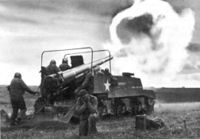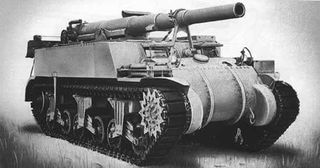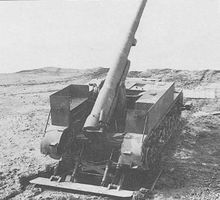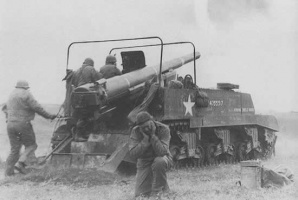M12
M12 (Stock)
| 1400000 가격 |
| 350 내구력 |
| 26.76 / 27 kg중량 |
- 지휘관
| 50.8/19.1/19.1차체 장갑(정면/측면/후면, mm) |
| 19.1/0/0포탑 장갑(정면/측면/후면, mm) |
| 400 마력엔진 출력 |
| 38.6 km/h최대 속력 |
| 18 도/초회전 속도 |
| 950 기본 포탄 공격력 |
| 85 mm기본 포탄 관통력 |
| 19 클립 재장전 시간 |
| 12 도/초포탑 회전 속도 |
| 370 m관측 범위 |
| 325 m통신 범위 |
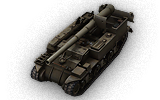
It is not all that different from the M41. As is par for the American SPGs it has a slow hull traverse speed, but a respectable top speed and acceleration.
Compatible Equipment
Compatible Consumables
Player Opinion
Pros and Cons
Pros:
- Gun range: stock: 1350 m, top: 1400 m
- Good damage
- Good accuracy
- Good gun arc
Cons:
- Horrible traverse speed
Performance
After firing 500 shots with the tank's M1A1, you'll get the feeling that most of its damage comes from splash and so called 'lucky shots', and not so much from clean hits. Add low penetration value to the mix, and it becomes a rarity that you'll hit for more than 1.000 damage. Expect to do around half that (500ish). When aiming, the lack of traverse speed is compensated by the good horizontal gun arc, reducing your need to turn before shooting.
Early Research
- install Radio from previous SPG (M41)
- install Engine researched by T40 or M3 Lee
- research suspension first
- research gun next
Historical Info
The 155 mm Gun Motor Carriage M12 was a U.S. self-propelled gun developed during the Second World War. Only 100 were built; 60 in 1942 and a further 40 in 1943. It mounted a 155 mm gun M1917, M1917A1, or M1918 M1, depending upon availability: a weapon derived from the nearly identical French 155 mm GPF gun of World War I vintage. The M12 was built on the chassis of the M3 Lee tank (some sources claim that later M12 used the M4 Sherman chassis, but this might be a confusion with the M12's use of "Sherman-style" bogie trucks with trailing idlers). It had an armored driver's compartment, but the gun crew were located in an open topped area at the back of the vehicle. An earth spade (similar to a bulldozer blade) at the rear was employed to absorb recoil. This layout, a large gun mounted in an open mount at the rear with a spade, was the pattern adopted for many years by other heavy self-propelled artillery.
During 1943, the vehicles were used for training or put into storage. Before the invasion of France, 74 M12s were upgraded in preparation for combat operations. They were employed successfully throughout the campaign in NW-Europe. Although designed primarily for indirect fire, during assaults on heavy fortifications, the M12s were sometimes employed in a direct-fire role.
Limited storage space meant that only 10 projectiles and propellant charges could be carried on the vehicle. Given this, a similar vehicle, but without the gun, was produced as the Cargo Carrier M30. This was designed to transport the gun crew and additional ammunition. In operational conditions, the M12 and M30 would serve in pairs. The M30 was armed with a .50-caliber Browning M2 machine gun. It could carry 40 rounds of 155 mm ammunition.
The sole surviving M12 GMC is displayed at the Fort Sill museum [1]. It was stored at the United States Army Ordnance Museum in Aberdeen, Maryland, USA, before being transferred to Fort Sill in November 2010.
Historical Gallery
Sources and External Links
| Light Tanks | |
| Medium Tanks | |
| Heavy Tanks | |
| Tank Destroyers | |
| Self-Propelled Artillery |
| USA | |
| UK | |
| Germany | |
| USSR | |
| China | |
| Japan |
